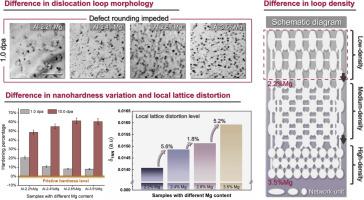镁合金的辐照硬化主要是通过控制初期缺陷的圆弧而起主导作用
IF 14.3
1区 材料科学
Q1 MATERIALS SCIENCE, MULTIDISCIPLINARY
引用次数: 0
摘要
溶质元素对铝(Al)合金的力学性能起着重要的控制作用,但辐照诱导的显微组织、力学性能以及溶质镁(Mg)原子与缺陷的相互作用机制之间的关系尚不清楚。通过原位离子辐照、纳米压痕和第一性原理计算,系统地研究了溶质Mg原子对铝合金辐照缺陷和硬化行为的影响。结果表明,Mg含量、显微组织演变和辐照硬化之间存在较强的相关性。Mg含量的增加在初始阶段抑制了位错环的生长和相互作用,延缓了网络单元的形成,从而减小了网络单元的尺寸。这导致高mg含量合金在相同剂量下表现出较低的位错网络结密度和延迟的辐照硬化。而在低mg含量铝合金中,位错环的生长障碍较小,并倾向于沿优先方向发展成细长的形态。这些现象可归因于溶质缺陷对的形成,其中Mg原子-由于其较大的原子尺寸和与Al原子的弱键合-产生局部弹性场,优先捕获空位。虽然高Mg含量可以增强初始溶质强化,但过量Mg会促进溶质团簇,导致辐照后形成更多的团簇。Mg的增加也增强了点缺陷的局部势垒效应。这有助于抑制缺陷的舍入,并在低剂量下导致更小的平均尺寸和更高的位错环数密度。此外,溶质缺陷对的形成影响了网络形成的动力学。这些发现为辐照铝合金的成分-缺陷-性能关系提供了新的认识,并为核用铝合金的设计提供了指导。本文章由计算机程序翻译,如有差异,请以英文原文为准。

Mg-content dominates irradiation hardening in Al alloys by controlling the defect rounding at the initial stage
Solute elements significantly control the mechanical properties of aluminum (Al) alloys, yet the correlation between irradiation-induced microstructures, mechanical properties, and the interaction mechanism of solute magnesium (Mg) atoms with defects remains unclear to date. The influence of solute Mg atoms on irradiation defects and hardening behavior in Al alloys was systematically investigated via in-situ ion irradiation, nanoindentation, and first-principles calculations. The results revealed a strong correlation between Mg content, microstructural evolution, and irradiation hardening. Increasing Mg content inhibits the growth and interaction of dislocation loops at the initial stage, postponing the formation of the network unit and thereby reducing their size. This leads to alloys with high Mg-content exhibiting a lower number density of dislocation network junctions and delayed irradiation hardening at the same dose. In contrast, dislocation loops in low Mg-content Al alloys experience less growth impediment and tend to evolve into elongated morphologies along preferential directions. These phenomena can be attributed to the formation of solute-defect pairs, where Mg atoms—due to their larger atomic size and weak bonding with Al atoms—generate local elastic fields that preferentially trap vacancies. Although higher Mg content enhances initial solute strengthening, excessive Mg may promote solute clustering—leading to more clusters formed after irradiation. Increasing Mg also strengthens the local barrier effect on point defects. These contribute to inhibiting defect rounding and result in a smaller average size and higher number density of dislocation loops at low doses. Further, the formation of solute-defect pairs influences the kinetics of network formation. These findings provide new insights into the composition-defect-property relationship in irradiated Al alloys and offer guidance for the design of Al alloys for nuclear applications.
求助全文
通过发布文献求助,成功后即可免费获取论文全文。
去求助
来源期刊

Journal of Materials Science & Technology
工程技术-材料科学:综合
CiteScore
20.00
自引率
11.00%
发文量
995
审稿时长
13 days
期刊介绍:
Journal of Materials Science & Technology strives to promote global collaboration in the field of materials science and technology. It primarily publishes original research papers, invited review articles, letters, research notes, and summaries of scientific achievements. The journal covers a wide range of materials science and technology topics, including metallic materials, inorganic nonmetallic materials, and composite materials.
 求助内容:
求助内容: 应助结果提醒方式:
应助结果提醒方式:


